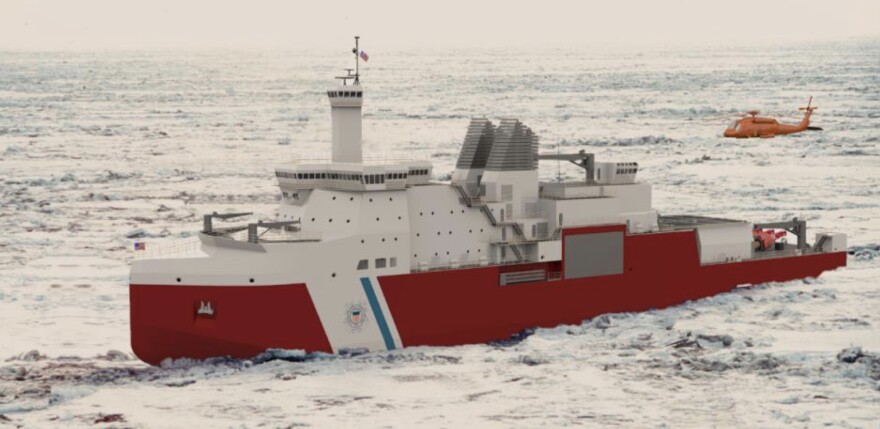The Coast Guard’s first heavy icebreaker in nearly 50 years is due in 2025. U.S. Sen. Dan Sullivan says the country can’t wait that long.
Sullivan is among those advocating for leasing or buying a medium-weight icebreaker in the meantime, to bridge the gap until the new billion-dollar icebreaker is ready. At a hearing in October, he prodded the head of the Coast Guard, asking if “we’ve made progress” on a short-term icebreaker lease.
The Coast Guard commandant said he’s considering acquiring an icebreaker to serve in the gap years. That’s a shift that began to surface last year. Before that, the Coast Guard adamantly rejected using the only icebreaking ship on the market.
Eventually, the Coast Guard will have a fleet of new heavy icebreakers, built to its specifications. Congress has authorized three and fully funded the first two, but complications from the COVID-19 pandemic have delayed the start of construction by a year. After delivery, the Coast Guard needs to test and ready its new ship for service, pushing the icebreaker's first mission to 2027.
At stake in the icebreaker lease debate is the nation’s ability to assert its presence in the Arctic during the gap. Also on the line: millions of dollars and the fortunes of a politically influential company that owns an underemployed icebreaker.
Sullivan has said it’s the mission that he cares about. The Coast Guard’s only heavy icebreaker in service is nearly 50 years old and needs constant maintenance.
“We’re one catastrophic maintenance failure away from having no heavy icebreaking capacity at all,” said a Sullivan spokesman.
Discussions about leasing a ready-made icebreaker get specific in a hurry. The country has just two major icebreakers in private hands, according to the Congressional Research Service. One ship is leased to the National Science Foundation. The other is the Aiviq, a $200 million vessel that’s been wearing a metaphorical “lease me” sign for years.
The Aiviq’s owner, Louisiana-based company Edison Chouest, built it to support Royal Dutch Shell’s plan to drill in Arctic waters. But Shell gave up that plan in 2015, and Edison Chouest has been trying to find work for its icebreaker ever since.
Alaska Congressman Don Young tried pressing the Coast Guard to accept the Aiviq back in 2016.
“I know you’ve got the proposal on your desk, by the way,” a frustrated Young told the Coast Guard’s second in command, at a 2016 hearing. “It’s already been laid on your desk and it’s an automatic no. Why?”
The vice commandant of the Coast Guard at the time, Admiral Charles Michel, insisted the ship wasn't suitable for the Coast Guard's many missions, including military service.
“Military service,” Young scoffed. “I’m talking about moving ice!”
In the 2020 election, the owners and executives of Edison Chouest were among Young’s top campaign donors.
In 2016, the shipbuilders made political contributions totaling more than $2 million, mostly to Republicans, including the campaigns of both Alaska senators.
Edison Chouest also spends $300,000 a year to lobby Congress, partly on federal ship acquisition. The company did not respond to a phone message seeking information for this story.
At the October hearing, Sen. Sullivan didn’t mention the Aiviq, or any specific icebreaker that might be for lease. While the Aiviq is the only domestic icebreaker available, the Trump White House was considering leasing Finnish icebreakers, Sullivan said last December. But no contract was signed and after the Biden administration began the next month, the whole leasing idea seemed to stall.
The merits of leasing a polar icebreaker did not get high marks in an extensive study a few years ago.
Retired Navy Admiral Richard West chaired a National Academies of Sciences committee that explored icebreaker acquisition, at the request of Congress.
“After we looked at all the leasing issues, we said leasing should be limited strictly to a one-time look at a specific mission, for a short period of time," West said.
Amon other findings, the peer-reviewed 2017 report concluded buying would be cheaper than leasing.
West's committee instead recommended “enhanced maintenance,” to keep the old Polar Star in service for another 10 years, until the new ice breakers are ready. That’s what the Coast Guard is doing, but in 2021, with the new heavy icebreakers still years away, the idea of leasing an ice breaker for the gap years is still on the table.
Meanwhile, the Aiviq has a new summer gig in Antarctica. Six years after it lost the job it was built for, the ship is now chartered by the Australian Antarctic Division to support its current research season.




